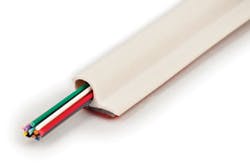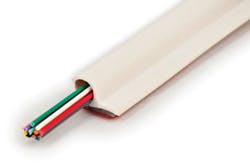For some, frustration with demarcation extension remains standard
From the April, 2015 Issue of Cabling Installation & Maintenance Magazine
Twenty-five years after the FCC amended its definition of the demarcation point, extending the demarc can still give some private-network owners fits.
By Patrick McLaughlin
It has been 16 months since this publication covered the idea of customer-premises demarcation in detail ("Demarc extension is mostly uncharted territory," December 2013). In those 16 month, by nearly any measure, little has changed related to the tasks and challenges associated with the stretch of cabling commonly called the demarc extension. Demarc Extension Nationwide (www.demarcextension.com) defines that stretch of cabling as follows: "The transmission path originating from the interface of the access provider's side of a telecommunications circuit demarcation point within a premises and ending at the termination point prior to the interface of the edge customer premises equipment [CPE]. This may include in-segment equipment, media converters and patch cords as required to complete the circuit's transmission path to the edge CPE."
Veterans of in-building wiring systems likely are unsurprised that nothing has changed over the past 16 months; many would argue that nothing has changed in the nearly 25 years (August 1990) since the Federal Communications Commission (FCC) amended its definition of the term "demarcation point" to help clarify confusion that existed over the location(s) of demarcation points in multi-unit buildings. That 1990 amendment sought to ensure the demarc would be near the minimum point of entry (MPOE), which is the point at which the service provider's cabling enters the premises.
An epic tale
Despite the FCC's efforts at clarification, some end-user organizations continue to face challenges when obtaining circuits from service providers and extending those circuits to their respective networks. One such epic challenge was recalled in a post to the blog Art of Troubleshooting (artoftroubleshooting.com) by that blog's author, Jason Maxham. Maxham has authored an e-book of the same title, which is available for download at no cost. In a blog post dated November 2014 and titled "Border Lines," Maxham uses service providers' treatment of the MPOE as a symbol of effective troubleshooting. A service provider's technician begins troubleshooting at the MPOE; if the network is not working there, the technician knows a problem lies within the service provider's network and therefore is the service provider's responsibility. If the network is working at the MPOE, the problem lies in the customer's network and is the customer's responsibility.
Maxham then uses the MPOE as a metaphor, describing the contractual, business-relationship, organizational, legal, and social boundaries that exist in business dealings. He concludes the blog post by re-telling the story of when, as a corporate chief technology officer, he went through an "epic struggle to procure a high-speed data line connecting our office in the Presidio of San Francisco to one of our colocation facilities in Bayview, about 6 miles away as the crow flies." To point out the level of complexity that can be involved in such a circuit turnup, Maxham recalled, "The cast of characters in my saga included a major telecom firm, a federal agency, a state regulatory commission, the building owner of the colocation facility, another company that we were sub-leasing space from, our Internet service provider, and us. Within this group was a tangled web of business, legal, and technical relationships. In retrospect, half the battle was just figuring out who had jurisdiction to make a particular decision. … Take the meet-me-room, where our circuit was to be handed off from the telecom firm to our ISP. At the time, they were embroiled in a dispute with the colocation building owner over crossconnect fees and they absolutely refused to pay to connect our new line. It was a standoff that lasted for several weeks … Also, getting this circuit somehow triggered a review of the contract by the California Public Utilities Commission. Weeks lost there, too. Although this line required a fairly simple physical connection (strands of fiber-optic cable from point A to B), mostly already existing, the route unfortunately snaked through all these various fiefdoms."
After a fairly entertaining walk through the tangles of red tape he had to withstand, Maxham concluded by recalling, "Even after the circuit was turned up, we spent a few more months troubleshooting problems discovered by actually using it. There was one particularly embarrassing rollback … It occurred after a failed switchover rained down chaos on our operations. This was the beginning of my education in networking arcana, with a deep dive into the meaning of the three letters M-T-U [maximum transmission unit]."
Too many cooks?
While told as both an entertaining and informative true tale, this story of circuit turnup can strongly resemble the experience of many. On the FAQ page of its website, Demarc Extension Nationwide explains, "When completing a telecommunications rollout across multi-site locations throughout the country, multiple local access providers are required. There is a large amount of time, cost and effort to manage the project and coordinate field services in addition to other requirements."
Demarc Extension Nationwide also details the typical process for a T1 line extension, in which the buyer orders a T1 from an Internet Service Provider: "In such a case the buyer is actually order two services—a port and the T1 loop. The port is the actual device at the ISP's end which provides Internet access to the buyer. The loop is the private line that connects the point of delivery (in this case the location of the buyer) to the ISP's port that provides internet access. Now the loop is actually purchased from the local access provider as they are the entity that legally owns it and can sell the local network. The LEC is mandated by law to deliver a local loop to the MPOE of a building being serviced by an ISP. This requires them to bring lines to the MPOE of a building, but no further.
"At this point, if the terminating router of the T1 is not in the same place as the MPOE (which in most cases, it isn't), then a demarc extension is needed to take the connection forward to the end-user location within the building. Based on the complexity of the extension, the ILEC may extend the demarc of the circuit for a cost," Demarc Extension Nationwide concluded.
A residential reprieve
Not every connection from the MPOE to the user network is fraught with these challenges. In many cases, the fewer the number of parties involved, the simpler an extension can be. 3M (3M.com) has built a line of products that is meant to simplify the physical connection of the MPOE in fiber-to-the-home installations at multiple-dwelling units (MDUs). Though not nearly as complicated as the bureaucratic nightmare that Jason Maxham described, fiber-to-the-home projects can present their own sets of obstacles.
"Increased engineering, longer installation times and higher costs associated with fiber deployments in brownfield MDUs have hindered and slowed the ability of service providers to fully realize the financial promise of the MDU category of housing. Deploying fiber in existing apartments and condominiums is challenging, on many fronts," explains 3M's Linnea M. Wilkes in the white paper titled "Overcoming the challenges of fiber deployment in multiple dwelling units."
"When it comes to existing MDUs, no two are alike and no single solution fits all … Engineering challenges arise when attempting to retrofit existing structures for fiber … Outside plant solutions don't translate easily into an MDU environment, where overcoming space restrictions and aesthetic objections are significant challenges. Older buildings are already wired with multiple cable media, creating congestion both in riser and horizontal applications."
3M developed the OnePass system to simplify the extension of fiber cabling to the individual dwellings in an MDU. Wilkes is recognized as an inventor of one of the patented products that is part of the OnePass system (U.S. Patent No. 20100247052 A1). The patent is titled "Low profile fiber drop point of entry system and method of installing." The product is described as follows in the patent: "A low-profile telecommunications fiber drop point of entry system for an interior room of an MDU, school, hotel, hospital, MTU or other commercial or residential location. The system includes a duct having one or more optical fiber communications lines and mountable to a first wall. The system further includes an access and storage structure at least partially disposable behind the first wall. The structure includes a first base unit having a first wall mounting portion of the duct. The first wall mounting portion includes a main port to fit over a hole formed in the first wall, the structure having a fiber slack storage area disposed between the first wall mounting portion and the first cover."
The OnePass system was introduced in 2009, and 3M reports many successful implementations in MDUs.
Whether through invention, ingenuity, or incalculable effort, the art of running cabling from a demarcation or minimum point of entry to a private-network owner remains a reality to be dealt with.
Patrick McLaughlin is our chief editor.
Archived CIM Issues

